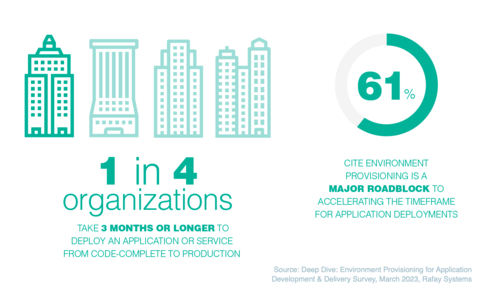One in Four Organizations Take Three Months or Longer to Deploy an Application or Service Predominantly Due to Challenges with Provisioning Cloud-Native Environments
Rafay Systems, the leading platform provider for Kubernetes Management and Operations, today announced independent research that found a developer experience (DevEx) gap between what application developers expect from their organization’s environment provisioning process and the methods currently available to them. The “Understanding Environment Provisioning for Application Development and Deployment” survey of over 500 platform teams—composed of platform and cloud engineering, architecture and operations professionals—and application developers at enterprises revealed that a quarter of organizations (25%) reportedly take three months or longer to deploy a modern application or service after it’s code complete. The majority of respondents (61%) indicated that environment provisioning is a major roadblock to accelerating the timeframe for application deployments.
This press release features multimedia. View the full release here: https://www.businesswire.com/news/home/20230321005525/en/

Findings from the “Understanding Environment Provisioning for Application Development and Deployment” survey of over 500 platform teams and application developers at enterprises. (Graphic: Business Wire)
The research also revealed that environment provisioning is mired in manual processes and infrastructure dependencies that affect the developer experience—almost all respondents (91%) believe that it is important for application development and delivery, but nearly half (45%) are not satisfied or just somewhat satisfied with their organization’s current process. Because of inefficiencies and complications with provisioning environments, both platform teams and application developers concur that it would be valuable to have a self-service workflow that streamlines the process and provides the right level of governance and automation controls for environment provisioning.
“Environment provisioning is a critical step in the release of modern applications and services,” said Mohan Atreya, SVP of products and services for Rafay Systems. “However, our research revealed that many organizations’ current environment provisioning processes are inefficient, complex and do not fully meet the expectations of developers nor platform teams. This delays the realization of the business benefits those applications provide – sometimes for up to six months or more.”
Differing Expectations for Environment Provisioning Process Leads to DevEx Gap
Platform teams and application developers are misaligned on the perceived efficacy of their environment provisioning process.
While 61% of platform teams are very satisfied with their organization’s current process for environment provisioning, over half (52%) of developers are unsatisfied or only somewhat satisfied. These developers stressed that the process is complicated, time-consuming and lacks enough automation. They cite the following perceived inefficiencies:
- Lack of automation between DevOps and core developer workflows (55%)
- Rolling out environments for applications takes too long (41%)
- It takes too much time to learn about and stay up to date with how to provision environments in my datacenter or cloud infrastructure (36%)
- It’s too complicated to provision environments in my datacenter or cloud infrastructure (33%)
On the other hand, most platform teams are content with their organization’s current environment provisioning process. However, there is still a considerable number of these technology practitioners who expressed being unsatisfied or only somewhat satisfied (39%). They indicated the following pain points that include a lack of standardization, training, visibility and governance:
- No standardized way to deploy and manage environments (43%)
- It takes too much time and effort to train development teams on how to provision environments (41%)
- Lack of visibility into environment resources including usage, costs and performance metrics (38%)
- Lack of governance around software/tools that are used (35%)
- Not enough guardrails around operations, optimizing processes, reducing risk and controlling costs (27%)
Time-Intensive Application Deployment Processes are a Roadblock to Innovation
Although 59% of all respondents said it currently takes less than a month to deploy an application or service from code-complete to production, a significant group of respondents report a longer process. In fact, 25% take three or more months, and 13% take even longer at 6 months or more.
Platform teams and application developers cited the following reasons why current processes for environment provisioning inhibit their ability to deploy an application or service—from code-complete to production—in their ideal amount of time:
- They and their team have to wait on someone else (e.g., operations) or a ticketing-based system to provision environments (57%)
- There are too many software/service dependencies between the application and environment that need to be tested/approved/validated (49%)
- It takes too long to gain/configure/approve access to new environments (30%)
- Lack of automation to procure environments or environments must be manually deployed (27%)
Platform Teams and Application Developers Agree: Self-service is Key
It’s evident that both groups are experiencing roadblocks to accelerating environment provisioning, but there is a silver lining. Despite differing opinions from platform teams and application developers, both parties unanimously agree on a solution for shortcomings in their current environment provisioning process—self-service. Nearly all platform teams (94%) and application developers (89%) believe it would be valuable to have a self-service workflow or portal where developers can provision environments themselves.
“Current environment provisioning processes hamper overall engineering efficiency. Streamlining the developer experience with a self-service workflow or portal will not only speed up the application delivery process, but also better position enterprises to experience the business benefits of modern applications faster than ever before,” Artreya concluded.
Additional Resources
- View the eBook: Deep Dive: Environment Provisioning for Application Development & Delivery Survey
- Follow Rafay on Twitter and LinkedIn
- Read the Rafay Blog: The Kubernetes Current
About Rafay Systems
Rafay delivers the first Kubernetes management and operations platform purpose-built for platform teams. Rafay's cloud-made solution, Kubernetes Operations Platform, provides the automation and governance capabilities that platform teams need to standardize Kubernetes toolsets and workflows. With Rafay, platform teams at MoneyGram, GuardantHealth, Verizon and many other companies are operating Kubernetes environments across data centers, public cloud and Edge environments with centralized visibility and access control, environment standardization, and guardrail enforcement. As a result, platform teams are able to deliver self-service and automation capabilities that delight developer and operations teams. For more information, please visit www.rafay.co.
View source version on businesswire.com: https://www.businesswire.com/news/home/20230321005525/en/
Contacts
Jane Daguio
Bhava Communications for Rafay
rafay@bhavacom.com
805-598-3016


















